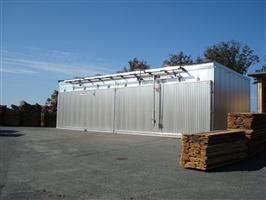As reducing the spread of pests and disease continues to be a major consideration in shipping, ISPM 15-compliant standards must be maintained in all wood packaging materials (WPM) being used to export goods. This means that WPMs must be either fumigated or treated with heat. Because of the detrimental effects associated with fumigation,
heat treatment is the preferred method.
This being said, there is a bit of confusion surrounding heat treatment methods. Often “kiln dried” and “heat-treated” are thought to be the same thing...but wait...there’s a difference!
Heat Treatment
Think complete sterilization! The goal in heat treatment is to completely eradicate any and all living organisms in the wood. This process is similar to pasteurization in other industries. The lumber used to construct crates and pallets must be thoroughly heated to reach an internal core temperature of 56c for 30 minutes. Lumber that has undergone heat treatment can sometimes appear darker, or look worn or older. It’s not! The sap inside the lumber reacts to the heat process, creating a darkened stained appearance. It’s important to note that
heat treated lumber weighs less and is stronger.
Kiln Dried
Kiln drying is used to reduce the moisture content of wood. Lumber is stacked inside large heating rooms (kilns), and then heated to evaporate excess moisture. It is more of a curing process and the goal is to prevent excessive warping of sawn lumber, and to reduce the weight. Kiln drying processes can vary, but the goal is not sterilization, so often the internal temperatures are not high enough for long enough periods of time to effectively sterilize the lumber.
Because kiln dried lumber goes through such a wide variety of processes,
pallets and wooden crates used for export must be stamped with the correct heat treatment code to comply with the HT ISPM 15 standard. If your shipment gets to a border inspection station, and even just a single pallet is missing the correct stamp, the entire shipment can be held or rejected! Obviously, this results in huge costs and inconvenience, not to mention customers not receiving their products.
Only companies licensed by the Canadian Food Inspection Agency (CFIA) are eligible to manufacture ISPM 15 certified products. Don’t be fooled, check to see if your supplier/manufacturer meets the necessary requirements.
If you need more information, The Canadian Wood Pallet and Container Association has a great FAQ document details on HT ISPM 15.
